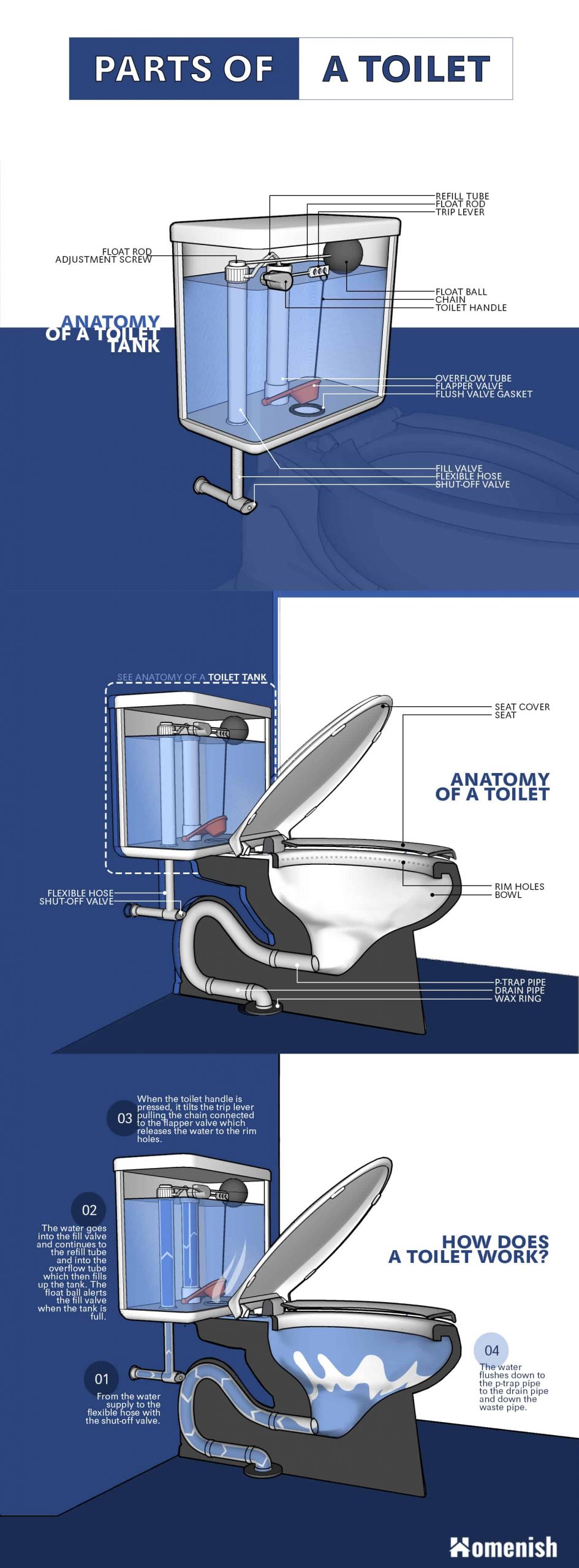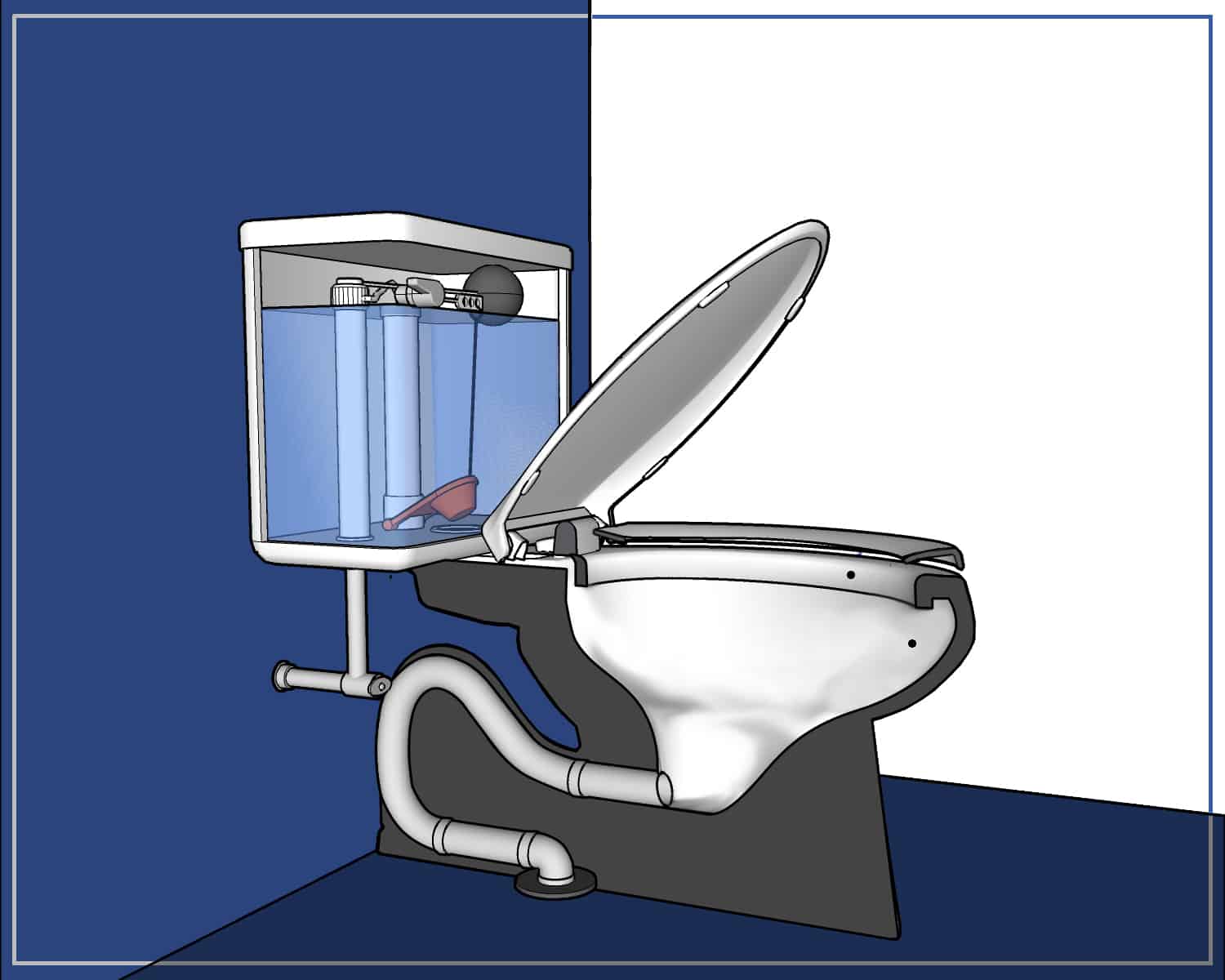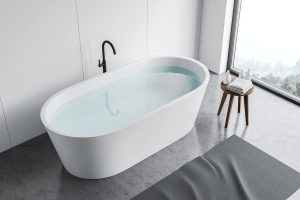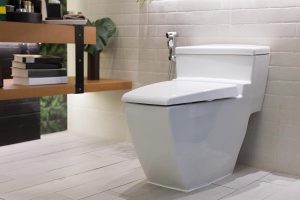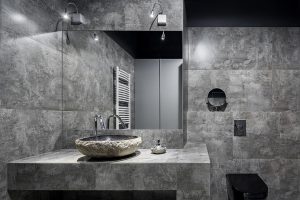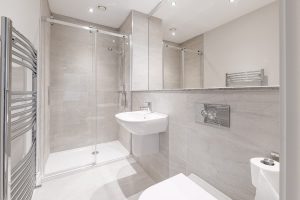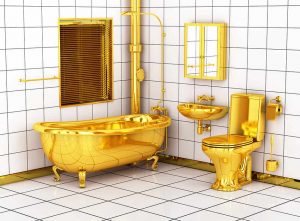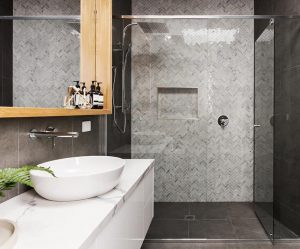Toilets are an essential part of any home, to the point that many of us can’t imagine our daily routines without them. However, they are a small mechanical and hydraulic marvel, able to operate steadily without the need for any electricity.
At least, until it doesn’t. Few mishaps can put a damper on a morning like a malfunctioning toilet. For all our reliance on a working toilet, relatively few people know how they work.
There are 3 amazing custom diagrams about the parts of a toilet. It’s very detailed and cool – you’ll love it.
Related:
In This Article
Why You Should Understand Your Toilet
Twenty percent of all toilets can leak. In order to repair a toilet, you should have some plumbing training or at least the guidance of an experienced plumber. Toilets are not rocket science, but the potential damages caused by an overflowing toilet can be expensive and messy.
然而,當你需要你的馬桶修好了舞會ptly and without overspending, it helps to know what each part does. This basic knowledge can help you troubleshoot minor problems, and it will protect you from dishonest plumbers who would take advantage of your ignorance.
Parts of a Toilet
A toilet’s basic mechanism feels simple: the change in pressure when you empty the tank helps move the water inside the bowl without having to touch it directly.
However, in order for this to work predictably and fully controlled from a lever on the outside, the toilet relies on a careful balance between different moving, water-tight, and fixed parts.
From the outside, it is easy to identify three main regions: the tank, the bowl (or throne), and the exterior plumbing.
Parts of a Toilet Tank
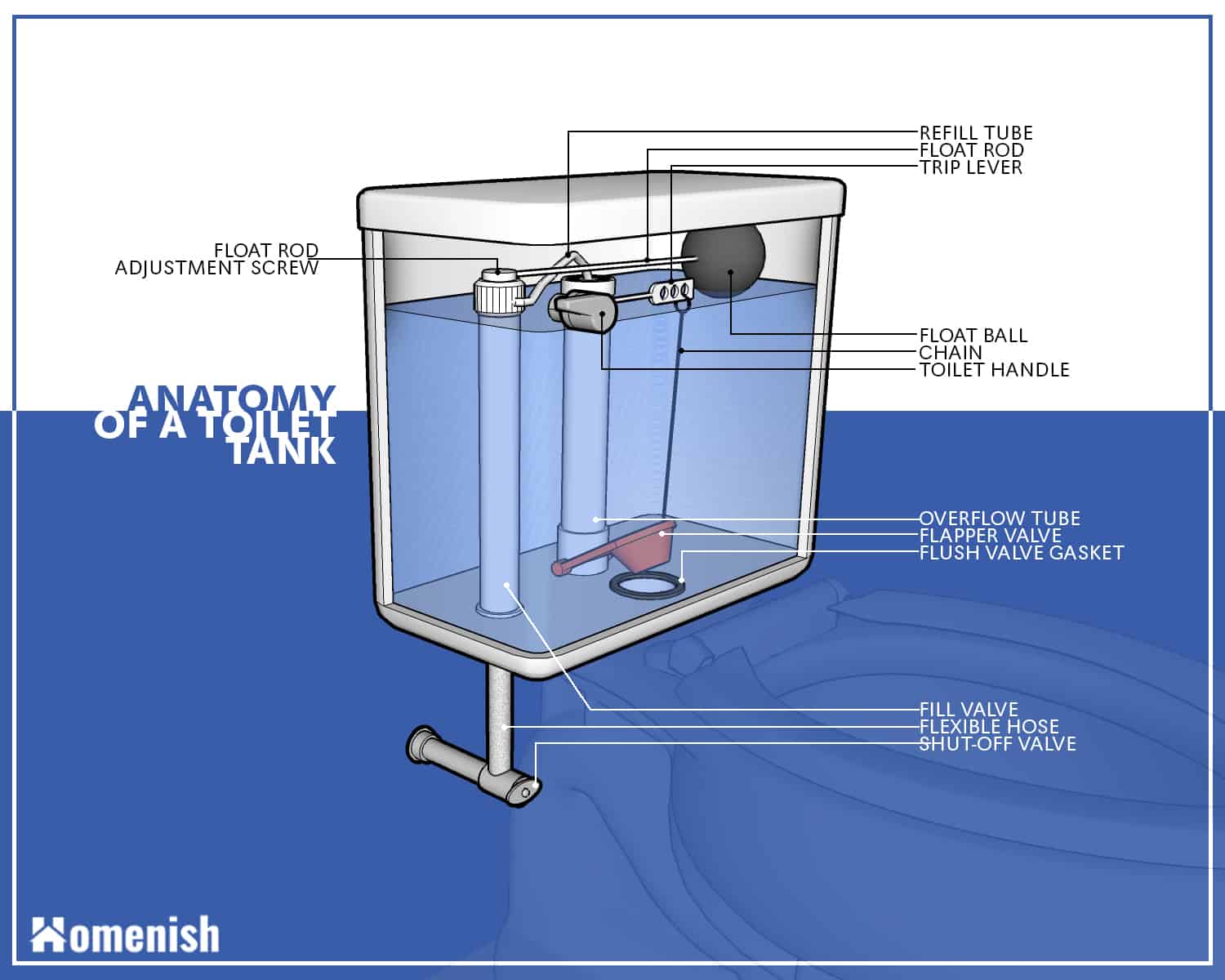
The tank is the main section of the toilet. It is usually made of a big porcelain box, held right behind your back when you sit.
馬桶水箱是最movi的一部分ng parts, as well as the most delicate one. If your toilet starts leaking, loses water pressure, or takes too long to refill, there’s a good chance that this problem originates in the tank.
The main parts are:
The toilet handle
There’s a good chance that the toilet handle is the only part of the toilet that you have interacted with. In any case, this is the only part of a toilet’s mechanism that is visible from the outside.
馬桶衝水handle is simple the small tank lever that you push whenever you want to flush the toilet.
The trip lever
The trip lever is a small plastic or metal bar held inside the tank. It is usually placed directly behind the toilet handle, and it will lift whenever you push the handle.
On the other end of the trip lever is the chain.
The chain
The chain connects the trip lever with the flapper valve that allows you to empty the tank. When the handle is pulled, it pushes the trip level up. In turn, this fastens the chain and opens the flapper valve.
The flapper valve
The flapper valve is a water-tight piece of rubber that seals the tank, keeping water in whenever the toilet is not being flushed. The flapper is connected directly to the chain on the top. When the chain is pulled, it will lift the valve and allow the water to pass through.
Flapper valves are one of the least resilient parts of a toilet, as the materials often wear out after a few years. This will cause the toilet to leak water constantly.
The flush valve gasket
馬桶衝水valve gasket sits on the bottom of the tank, directly beneath the flapper valve. It is basically the counterpart of the flapper valve, and it is meant to fit it perfectly in order to keep water in.
The fill valve
Usually located on the opposite extreme as the flapper valve and flush gasket, the toilet fill valve kicks off the mechanism that lets water come inside the toilet tank. It usually connects to a hole in the tank and is attached to a hose that eventually leads to the water supply (but more on that later).
The fill ore refill valve also includes a vertical refill tube that allows water to come up and then spill into the tank until it reaches the correct level.
The float ball and rod
The float ball and rod are responsible for ensuring your toilet doesn’t continue filling up forever until it eventually overflows and floods your bathroom. The rod is directly attached to the fill valve and holds up a small floating ball.
As water enters the tank, it pushes the floating ball up. Once the water reaches a certain level, the ball will rise to the point at which it lifts the rod. In turn, as the rod moves, it will cause the fill valve to close. This stops the flow of water coming into the tank.
The overflow tube
Float balls and rods are, unfortunately, not indestructible. Insects can poke holes in the ball, causing it to get full of water and making it too heavy to float. In addition, the rod may get rusty and stop moving properly, or the fill valve may get worn out. If this happens, your toilet will continue to use up water continuously until the point it overflows from the tank and into the floor.
Fortunately, there is one more failsafe installed inside your toilet tank. The overflow tube is meant to prevent this disaster by letting this extra water escape from the tank and into the toilet bowl directly.
The overflow tube is usually a small pipe attached to the back of the tank. Water will begin coming from the top of this tube once it goes above a certain level.
Main Parts of a Toilet (Bowl, Seat, Base, Plumbing)
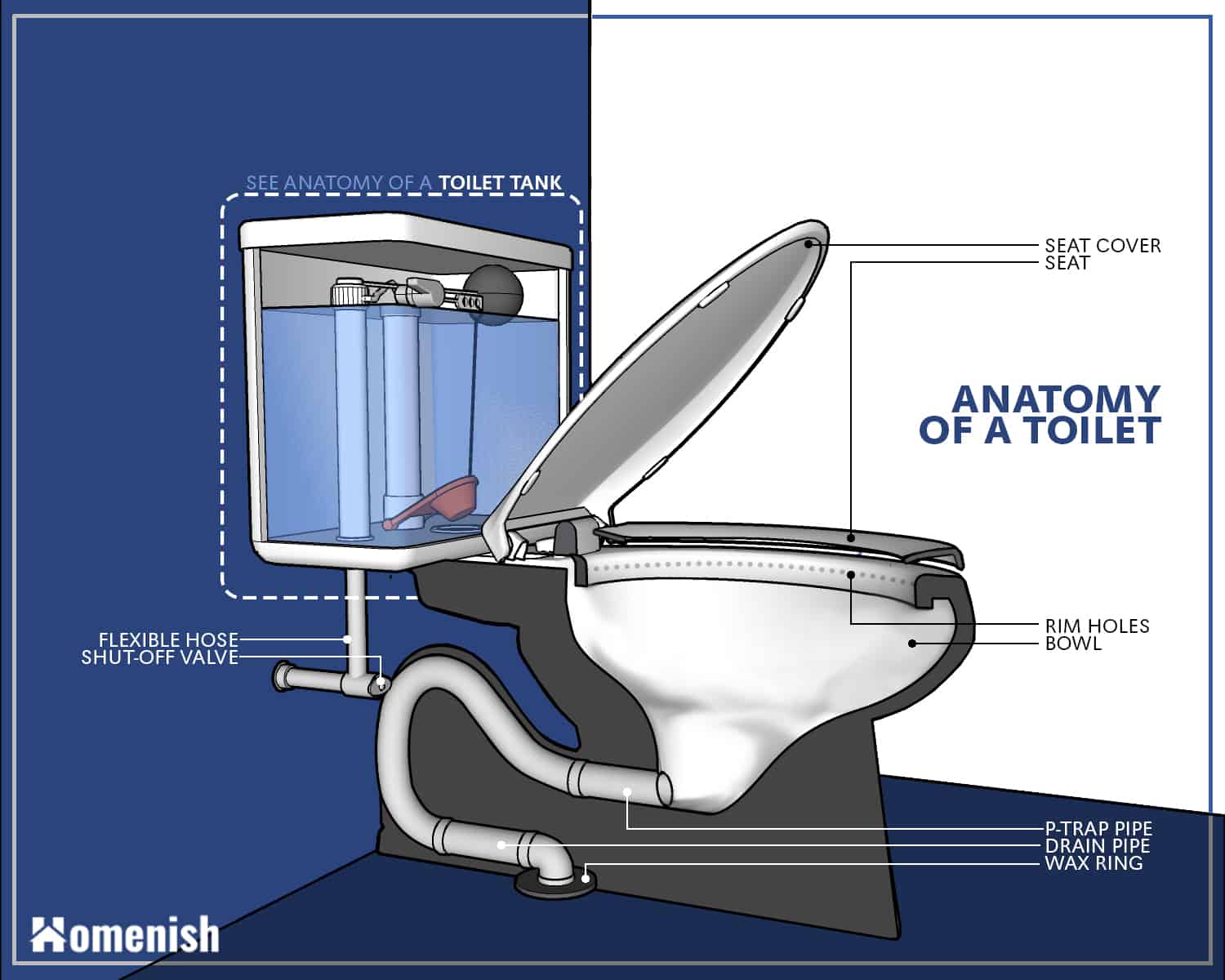
The Toilet Bowl
The toilet bowl is everybody’s favorite part of a toilet, as it constitutes one of our most intimate spaces. At first glance, this is a relatively simple part – just a big round piece in which you sit. However, behind the one-piece constructions lie a few more contraptions meant to keep you safe, comfortable, and dry while you ponder immortality.
The flapper valve gasket
This is the point where the bowl and the tank connect. When you flush the toilet, all the water that was being held in the tank flows out, pushing out the (now dirty) water inside the bowl. This is immediately replaced by the water inside the tank.
Rim holes
When you flush, most of the water passes quickly from underneath the toilet. However, some water also slides down along the sides of the bowl, washing off anything that may have been stuck.
This water enters through a series of rim holes located underneath the edge of the bowl. The strength of the flushing, plus the Coriolis forces, cause the water to circle around a bit, eventually finding its way down the drain pipe.
The Toilet Seat
Sitting directly on top of a cold porcelain bowl is not a pleasant experience. This is why most bowls have a toilet seat, lining the “sitting is” with warmer plastic or wood. The seat is usually held to the back of the bowl with a series of screws, using a simple hinge mechanism.
Seat cover
Let’s say it’s a very hot day, and you are looking forward to something cold under your skin, or you simply lack sensation in your buttocks. We won’t judge. Nevertheless, while you may be able to sit on the toilet without the seat, you should never flush without putting the seat cover (also known as the lid) down.
The seat cover protects your surrounding walls, towels, and shower doors from the contents of your toilet. When you flush, the rapid movement of water creates a plume, which sends that used water all over in every direction.
Just put the toilet seat down.
The Toilet Base
The base connects the toilet bowl with the floor and provides some extra space to secure it. It also helps hide a couple of additional safeguards that are meant to keep the water out of your floors.
The closet flange
Sometimes also knows as the toilet flange, this is a thick rubber ring that mounts the toilet to the floor. It also connects it to the drainpipe and provides extra insulation for the water inside. The closet flange is usually held together by a row of bolts and hidden beneath the base. Ideally, some sort of sealant should hold the base on top of the flange and glue them tightly together.
The Toilet Exterior Plumbing
The exterior plumbing of the toilet includes all the mechanisms and pipes that allow the clean water to come into the tank (inlet ports) and that takes the wastewater outside of the bowl (outlet ports).
Let’s start with the inlet ports:
Flexible hose
This hose carries water from your main water supply into the tank and connects to the fill valve. On the inside, most hoses are made of plastic. However, they are almost always covered in steel mail. This keeps them flexible but prevents any holes that could jeopardize the water pressure.
Shut off valve
The shut-off valve allows you to close the water inlet system completely and is usually located at the start of the flexible hose. If your toilet is running, leaking, or overflowing from any part, the shut-off valve will put a quick stop to the immediate problem. This will buy you some dry time until you can figure out what is truly wrong
Finally, the exit or outlet ports:
The P-trap pipe
The P-trap pipe is located immediately beneath the toilet bowl. This is a small U-shaped bend that holds a bit of water inside the bowl. This helps prevent any unpleasant smells from escaping whenever any human waste falls inside the bowl
The drain pipe
After passing through the P-trap pipe, the toilet drain pipe lets sewage and wastewater out of the bowl and into the sewage system.
How a Toilet Works
Now that you understand every part of a toilet, here is how it works step by step.
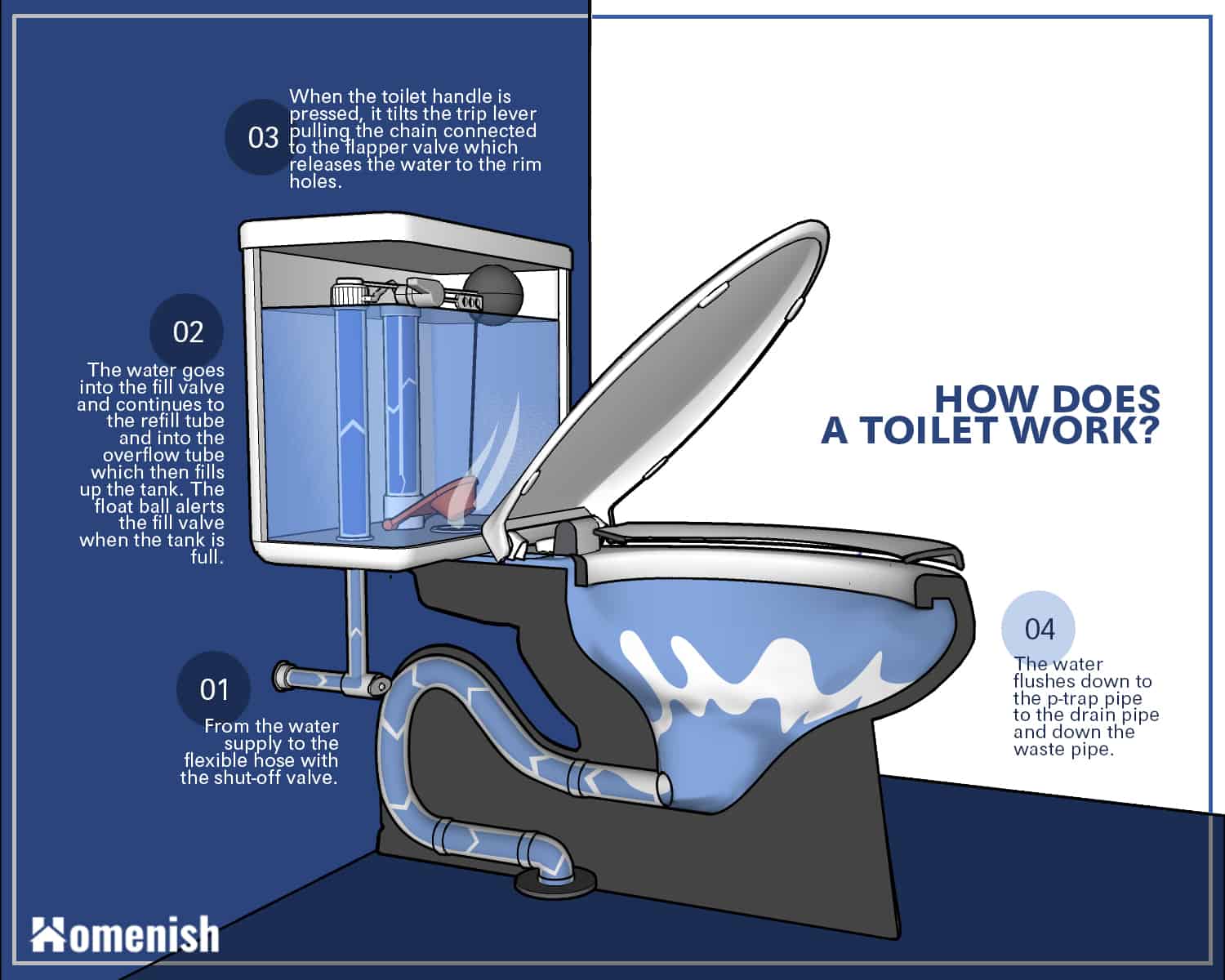
Full Infographic & Diagram of Toilet Parts
